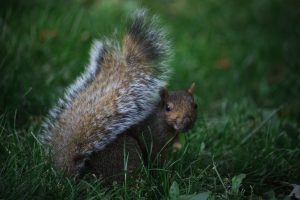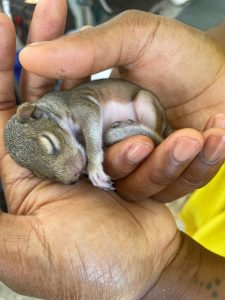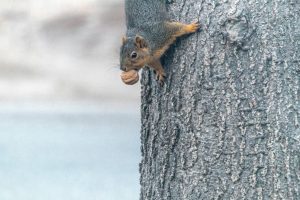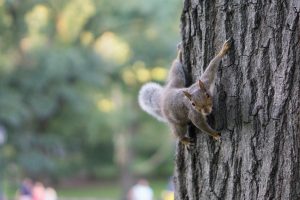
This November, we celebrated Wildlife Wednesdays with unique stories of gratitude for the animal kingdom. All around us, niche stories of connection, triumph, cooperation, and coexistence are tucked away amongst stands of slash pine, thickets of saw palmetto, and swampy wetlands. When we tune into these stories of gratitude, we develop an appreciation for the complex lives of the wildlife that live alongside us, and recognize our own place in the web of life.
From turkey vultures that help reduce carbon emissions, to North America’s only marsupial mammal, we explored the stories of animals that give us a few reasons to thank the wild, wacky world of wildlife. In the previous blog, we learned how mesopredators like red and gray foxes help maintain balance in our ecosystems. Be sure to check out this blog and others from this month-long series, and continue reading for our final story of gratitude this month.

The “squirrel next door”
Despite being one of our most conspicuous and common mammals, the Eastern gray squirrel (Sciurus carolinensis) is often overlooked, their fascinating lives hidden in plain sight. This rodent species is equipped with a variety of adaptations and quirky behaviors that help them survive in their environment.
Their large eyes—often described as “beady”—allow for the keen vision needed to keep watch for lurking predators, of which there are many. Squirrels are important prey animals for a variety of raptors, such as hawks and owls, as well as snakes, foxes, coyotes, bobcats, and more.
Outspoken squirrels
When a predator does get too close, Eastern gray squirrels will make sure that everyone knows. If you have ever found yourself suddenly within a squirrel’s “personal space,” chances are you have heard their unique vocalizations and seen the quick swishing of their tail as they bravely and intently watch your every move. Squirrels communicate through the use of vocalizations, visual cues and body language, as well as through scent. They can even detect potential danger in an area by catching a whiff of another squirrel’s elevated stress levels.
Save some for later!

Acting as prey for other animal species isn’t the only contribution that the Eastern gray squirrel makes to its environment. In areas where food sources may be limited during certain seasons, these clever seed savers bury or cache a variety of nuts and seeds just below ground, in various locations. While squirrels are able to remember where they have buried most of their own stash, some nuts and seeds will remain unrecovered, seeding the next generation of vital tree species, such as the Southern live oak (Quercus virginiana).
The acorns produced by those successful Southern live oaks when they grow up will continue to feed Eastern gray squirrels and a variety of other wildlife. This iconic tree’s spreading canopy also provides humans with a cool respite on hot, summer days. In addition to acorns and other nuts and seeds, Eastern gray squirrels will also eat bark, berries, and the occasional mushroom.
Trained acrobats

Gray squirrels could give any circus performer a run for their money. The next time you encounter one of these acrobats, take some time to appreciate their grace and agility, as they make daring leaps from branch to branch. An Eastern gray squirrel’s sharp claws allow them to cling securely to the bark of trees, and their specially adapted legs allow their feet to turn backwards, enabling them to climb headfirst down a tree.
Coexisting with Eastern gray squirrels
As you may have come to realize, each animal has its own place and purpose in the ecosystems within which they live. It is important that we learn to coexist with them, and adopt best practices in and around our homes to decrease the potential for unpleasant interactions. Common concerns with gray squirrels include nesting in attics and the use of bird feeders by squirrels. Check out this video from the Florida Fish and Wildlife Conservation Commission (FWC) to learn how you can discourage squirrels from nesting in your home and utilizing your bird feeders.
Thank you!
Thank you for following along with us this month. Florida’s wildlife lead very fascinating lives that often intersect with our own. Although November is coming to a close, making time for moments of gratitude is a practice that can be applied at any time, and can help deepen our sense of place and connection to the natural world.
Missed one of this series’ stories? Visit this link to find all of the blogs in the Stories of Gratitude for the World of Wildlife series. Interested in learning more about wildlife? For a whole collection of free educational resources about Florida’s fascinating wildlife species, visit our “Florida Wildlife” webpage.
Source: UF/IFAS Pest Alert
Note: All images and contents are the property of UF/IFAS.



